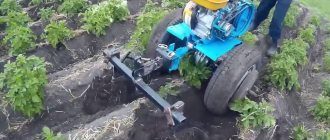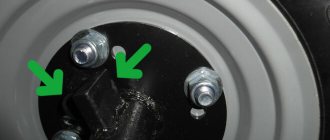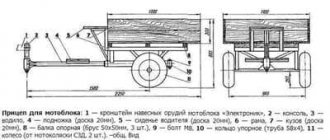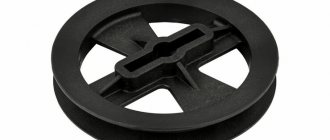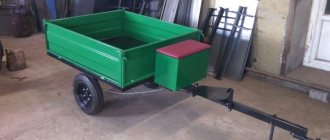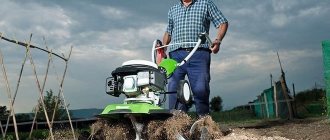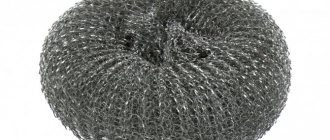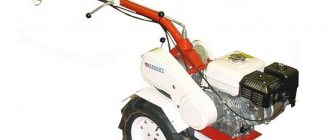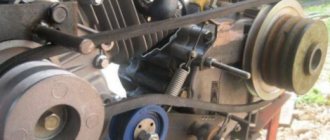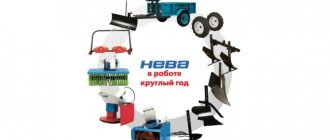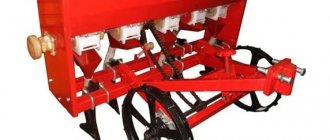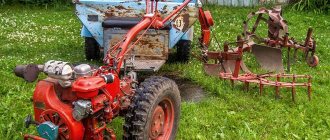Classification of cutters
According to the location of the cutters, there are side and mounted ones. The side ones are installed on both sides of the walk-behind tractor and operate from the drive shafts of the wheels. In fact, with this arrangement, these cutters replace wheels and set the equipment in motion.
The second type is a milling cutter, powered by a power take-off shaft, located at the rear of the unit and does not participate in movement. Motoblocks of the brands Tselina, Neva MB-1 and MB-2, MTZ have just such a cutter device.
Based on the design of knives, there are two types of cutters - saber-shaped (active, standard) and the so-called crow's feet.
Active cutters
The active cutter consists of a set of four powerful knives installed at an angle of 90° relative to each other. There can be two or more such sets on one axis. The number of additional cutters, as well as the size of their knives, depends directly on the performance of the walk-behind tractor. The knives of this cutter are in the form of curved strips, bent alternately in different directions. Their design and strength allow you to safely process virgin soil, as well as areas where stones and roots come across.
Crow's feet
The second design type of cutters is crow's feet. The product got its name from the unusual shape of the cutting elements, reminiscent of the feet of a goose. They have the shape of a triangle and are located on the edges of the racks. The number of cutting elements and the size of this module also depends on the power of the walk-behind tractor. The more racks with knives, the better the processing.
This cutter is capable of processing heavy virgin and clay soils, but in areas with increased vegetation and roots, the product will most likely become clogged.
Cultivators and harrows
The cultivator-harrow is considered highly efficient equipment for the MTZ-09N walk-behind tractor. She carries out preparatory work for planting crops. In particular, the cultivator-harrow for the MTZ-09 walk-behind tractor allows you to: loosen and level the top layer of soil, perform preparatory work before planting, remove the roots of weeds, fertilize the soil, do harrowing, cultivate the land after harvesting.
Read also: Diagram of a Chinese charger for a car battery
From the manufacturer
The Smorgon plant offers its customers two in one: a cultivator and a harrow. This design is called KB-00.000.
Features of the KB-00.000 cultivator-harrow
- Its dimensions are 60 cm in length, 160 cm in width and 50 cm in height;
- The working width can vary from 80 to 150 cm. Thanks to this, you can configure the cultivator-harrow for the MTZ walk-behind tractor in the required operating range. If you need to perform more precise harrowing between trees or bushes, then the knives are placed nearby, and if more voluminous work is required, then further away;
- The penetration depth of the cultivator can be adjusted in the range from 3 to 10 cm;
- Very high productivity, with its help you can process about 6000 m 2 / h;
- The cultivator is installed on the MTZ walk-behind tractor using a universal hitch. It allows you to securely fasten it for the entire period of operation;
- This is a simple design that has been proven to work over time. There is nothing superfluous in it, but at the same time it copes with the task perfectly on any soil, be it clay or hard.
Review of the KB-00.000 cultivator-harrow for the MTZ walk-behind tractor
Analogs
Khersonskaya offers its own version of a harrow for the MTZ walk-behind tractor - BR1-2.
How to properly assemble cutters on a walk-behind tractor?
Assembling the cutter can cause some difficulties, especially if you are doing it for the first time and alone.
First, you should familiarize yourself with the structure of the cutter.
The drawing below shows its main components:
- rotor axle (can be of different lengths, can be solid or split);
- finger with lock;
- knives (right and left);
- structural fastening elements (nuts, washers and bolts).
Also, do not forget to take into account the fact that the movement of the knives during operation is directed counterclockwise. Be careful when assembling the module - any deviation in the design will lead to the axis being unbalanced and the unit will skid to the side during operation.
We also suggest that you watch the video, which describes in detail the process of assembling cutters for a walk-behind tractor:
Virgin soil processing | Topic author: Lydia
It is possible to take 50 acres of virgin land. How to turn a plot into a normal vegetable garden, in what way and at what time of year is it better to start processing? Overgrown mainly with wheatgrass. The first time, I think, plow with a tractor, and then? Maybe it's better to spray something like Roundup first? Advise anyone who has experience. There is a powerful walk-behind tractor with a PTO, and the attachment includes a milling cutter with a working depth of 20 cm.
Lydia wheatgrass. in very hot weather, plow everything. after 2-3 days, when all the roots are dry, you can cultivate Natalya. in the same year, seedlings of tomatoes and Alla peppers were planted. If you plow in the heat, then no roundup is needed. the sun will burn everything. verified by personal experience, on 70 acres. go for it.
Egor✨) God, do not spray this infection under any circumstances if you do not want to remain without a harvest for several years. Unfortunately, I have personal bitter experience with this Antonin roundup. Search the Internet, you will find everything I told you. so don’t even think about getting involved with such a drug, consider other options. Good luck)
Ivan Despite the frightening answer, I will be the first to tell you that I treated a large area with HURRICANE in the spring, when the wheatgrass had already come out well. After 3 weeks it turned completely yellow and I plowed it with a tractor. Then the wheatgrass came out a little more after about two months. I tilled it again, harrowed the tractor and sowed winter wheat. There was a sea of wheat. No one had such a harvest. After the wheat, I sow mustard and plow it as fertilizer. The land is always good and so are the harvests.
Inna Do not poison the Earth. You can deal with grass without chemicals. And get rid of all the worms. Pasha, cultivate. then sow with green manure and everything will be SUPER for you. The result will be fertile soil. Come to us for garden and vegetable garden answers.
Valentina I am also only for mechanical processing: plowing, cultivating, sowing with green manure.
Homemade cutters for walk-behind tractor
In order to create a cutter for a walk-behind tractor with your own hands, you need to stock up on the following tools and workpieces:
- metal pipe (diameter no more than 42 mm);
- blanks for the cutting elements of the cutter (any unnecessary spare parts or pieces of metal will do. For example, you can use old car springs);
- welding;
- Bulgarian.
The cutting elements are adjusted to the required dimensions and sharpened if necessary. Then they need to be welded to the pipe in the appropriate order.
Experts recommend not making cutters with a diameter of more than 50 cm, since this will reduce the risk of breakage during operation. Below is a detailed drawing for making a crow's foot cutter:
When using cutters, do not forget about safety precautions and operating instructions for the product. Before starting, the cutters must be above the ground surface, and their immersion into the soil must be slow and smooth.
Rotary mower for motor tractor
This is the most common type of mower, which not only enjoys great success in the market, but is also actively manufactured independently by many craftsmen. The success of such equipment lies in its reliability and simplicity of design, as well as high performance.
The operating principle of such a device is very simple: several disks are mounted on a metal beam (frame). Several knives (2 – 8) made of hardened steel are mounted on disk hinges. When the discs rotate, the blades unfold and cut the grass. Thanks to such a simple mechanism, if a rotary mower breaks down, you can fix it yourself.
Today, such mowers are sold together with a grass catcher. This brings additional convenience when working with such equipment. You can also make a rotary mower with your own hands, but we will talk about this a little later.
Rotary mowers come in single-rotor and double-rotor types. The former align the cut grass relative to the equipment in one direction, and the latter – in the center between the rotors.
Such mowers are designed for motor tractors with a power of 10 - 25 hp. Models of such equipment are distinguished according to mobility, functionality, durability and performance. Among semi-mounted rotary mowers, the AgroService SB-1200 is popular. Among the budget mounted mowers for mini tractors and at the same time high quality is the DM 135.
Trailed rotary mowers are distinguished by their safety and require less power from a mini tractor. Basically all the work comes from the traction of the wheels. Such equipment can be mounted either from the rear or from the front using a PTO.
- Bolt M8-6gх16.58.016
- Washer 8 65G 016
- Right ski
- Transmission housing
- Bolt M8-6gх20.58.016
- Transmission side
- Belt A-950-II
- Cotter pin 2.5x25.005
- Nut M10-7N.5.019
- Pulley
- Stretching device
- Upper transmission
- Pad
- Angular gear housing
- Main transmission
- Washer
- Disc with knives
- Protective washer
- Transmission left
- Left ski
- Gear housing
- Transmission average
- casing
Which cutters are best for a walk-behind tractor?
Each type of cutter has its own disadvantages and advantages. When choosing cutters for a walk-behind tractor, you should take into account its power, as well as operating conditions.
For example, a saber rototiller is very durable due to its design and the material from which it is made. This type of cutter has integral knives, and they are made of high-carbon hardened steel. It has universal functionality, as it can work in any conditions and on different soils. Also, the knives of this cutter are easier to repair - you just need to install and secure a new cutting element.
The houndstooth cutter is also suitable for heavy soils and cultivation, but areas with turf or roots will be difficult for it to overcome. The equipment will clog and work poorly. Also, due to the peculiarities of its design, it is more often prone to breakdowns, and repairs are usually carried out using welding work, which is longer and unprofitable.
As you can see, each set of cutters is not without its advantages. When choosing, rely on the technical characteristics of your unit and the features of the upcoming work.
Making your own crow's feet
If the cutters on your walk-behind tractor are outdated, or you have a desire to improve your equipment, for example, reduce or increase the width and depth of processing, then you can make the part yourself. Often, such an idea can significantly improve the quality of land cultivation, as well as significantly speed up work.
These parts are characterized by a simple design, so you can make them yourself.
The simplest option is to study and analyze the design of industrial-type cutters, and then make some adjustments to it.
You need to pay attention to the fact that to assemble the cutters yourself, you will have to use individual drawings.
So, homemade nozzles of this type consist of the following parts:
- Sleeve. It can be made from a thick tube with a diameter of 50 mm.
- The flange is made of thick sheet steel. It can be shaped into a round shape, but it is much easier to make a square flange.
- Blade stand. Here you can use a steel corner. Some craftsmen use car springs to make this element.
- Medium blade.
- The far left blade.
Blades are best made from tool steel alloys. Some craftsmen use car springs for this purpose.
Using welding, the blades are mounted on stands that are attached to flanges. The flanges are attached directly to the bushing. Some opt for bolted fasteners, but such designs are not very reliable.
The “disadvantage” of the crow’s feet attachment is that this element is severely damaged during operation. As a result, the cultivator engine is subjected to additional load, and the operator becomes very tired. In order to minimize this, you need to put wheels on the axle on both sides, which will serve as some kind of limiters.
Read also: How to remove a rotary hammer bearing
In this situation, only the topmost soil layer will be processed. This option is convenient for cultivating turfy and heavily overgrown soil. After the first pass, the turf begins to break down. Next, the wheels are dismantled and additional processing is carried out to a given depth.
If homemade crow's feet are made correctly, then their quality will not be inferior to their industrial counterparts.
So, making crow’s feet yourself has the following advantages:
- you will have the opportunity to save money;
- you will make a part specifically for your cultivator;
- A correctly assembled homemade cutter is in no way inferior to factory products.
A tiller for a walk-behind tractor is one of the most common types of additional equipment for tillage. It is a set of special knives mounted on an axis. With their help, you can quickly and easily get rid of weeds and cultivate the soil on the site. In order to choose the optimal type of cutter for your walk-behind tractor, you should classify them a little.
Is it necessary to sharpen cutters for a walk-behind tractor?
There is no clear answer to this question. It all depends on the individual characteristics of the walk-behind tractor, the soil and the conditions of use. For example, sharpening is not necessary to process heavy soils with a powerful walk-behind tractor with reinforced cutters. You will not see any tangible effect from this procedure, you will just waste time and energy.
To process an area with a lighter walk-behind tractor with small cutters, sharpening is a good option for improving the quality of work. But there are downsides here too. Firstly, sharpening only lasts for a few hours, then the procedure will need to be repeated, and this is a long and labor-intensive process. Secondly, sharpened knives help crush the roots of weeds, and this in turn can only speed up their reproduction.
If you decide to sharpen the cutter, remove it from the walk-behind tractor and clean it from the soil. Use sandpaper to sharpen each cutting element very carefully so as not to damage them.
Description of crow's feet
The most important task of a walk-behind tractor in a garden or field is to fully plow the soil for subsequent sowing and/or planting. In this case, cutters are used - the main working part of the walk-behind tractor. The cutter is an axis with blades of different configurations. In the process of rotating along the axis, these knives seem to cut the layer of soil, plowing it. By the way, cutters are often called soil cutters. In this case, not only the top soil layer is cut off, but also all existing vegetation. That is, the cutters plow the ground and remove weeds.
There are several types of cutters. The most popular are saber blades. This design is collapsible. Houndstooth, on the other hand, is characterized by a cast configuration. They are made from carbon steel alloys. Their main feature is considered to be triangular-shaped knives, which ensures complete mixing and crumbling of soil pieces. This shape is explained by the need for high strength when processing hard soil.
Features of operation
This attachment is often used for plowing the soil for planting potatoes, when you need to get rid of large lumps of earth and organize the prevention of pests such as Colorado potato beetles. It is worth noting that experienced gardeners and agricultural industry workers say that this attachment does not cut down weeds, but only wraps them around itself. This begs the question: does it need to be sharpened? The answer will be positive. Once you sharpen this attachment, you will see how it will be much easier to cut down small plants, and it will also make working with hard soil easier.
